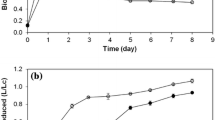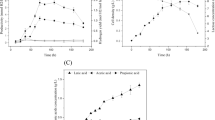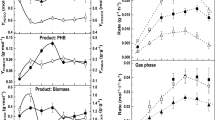Abstract
Hydrogen production by biological route is a potentially sustainable alternative. Nowadays, energy production from sustainable sources has become urgent for several countries as well as for international policies. In this perspective, hydrogen has gained substantial global attention as clean, sustainable, and versatile energy carrier. In the current work, the resulting effluent from dark fermentation, rich in organic acids, was used as substrate for the purple non-sulfur bacteria (PNS) Rhodobacter capsulatus. In the first stage, experiments were carried out in bioreactors of 50 mL to check the influence of the composition of the effluent dark fermentation. The results proved that the provision of a sugar source improved bio-H2 production. The lactose and lactic acid concentrations exceeding 4.4 and 12 g/L, respectively, resulted in a productivity of up to 37.14 mmol H2/L days. Based on initial conditions obtained on the previous assays, in the second stage, a photo-fermentation in enlarged scale (1.5 L) was performed with the purpose to monitor the production of hydrogen and metabolites, sugar consumption and growth cells during the process. It was observed that the maximum productivity obtained was 98.23 mmol H2/L days in 26 h of process.


Similar content being viewed by others
References
Abo-Hashesh M, Desaunay N, Hallenbeck PC (2013) High yield single stage conversion of glucose to hydrogen by photo-fermentation with continuous cultures of Rhodobacter capsulatus JP91. Biores Technol 128:513–517
Afsar N, Özgür E, Gürgan M, Akköse S, Yücel M, Gündüz U, Eroglu I (2011) Hydrogen productivity of photosynthetic bacteria on dark fermenter effluent of potato steam peels hydrolysate. Int J Hydrogen Energy 36:432–438
Avcioglu SG, Ozgur E, Eroglu I, Yucel M, Gunduz U (2011) Biohydrogen production in an outdoor panel photobioreactor on dark fermentation effluent of molasses. Int J Hydrogen Energy 36:11360–11368
Bianchi L, Mannelli F, Viti C, Adessi A, De Philippis R (2010) Hydrogen-producing purple non-sulfur bacteria isolated from the trophic lake Averno (Naples, Italy). Int J Hydrogen Energy 35:12216–12223
Clesceri L, Eaton AD, Greenberg AE (1998) Standard methods for the examination of water and wastewater, 20th edn. American Public Health Association, Washington
Cuartas-Uribe B, Alcaina-Miranda MI, Soriano-Costa E, Mendoza-Roca JA, Iborra-Clar MI, Lora-García J (2009) A study of the separation of lactose from whey ultrafiltration permeate using nanofiltration. Desalination 241:244–255
Das D, Veziroglu TN (2008) Advances in biological hydrogen production processes. Int J Hydrogen Energy 33:6046–6057
Davila-Vazquez G, Cota-Navarro CB, Rosales-Colunga LM, de León-Rodríguez A, Razo-Flores E (2009) Continuous biohydrogen production using cheese whey: improving the hydrogen production rate. Int J Hydrogen Energy 34:4296–4304
Eroglu E, Gunduz U, Yucel M, Eroglu I (2001) Effect of iron and molybdenum addition on photofermentative hydrogen production from olive mill wastewater. Int J Hydrogen Energy 36:5895–5903
Ferchichi ME, Crabbe ME, Gil G-H, Hintz W, Almadidy A (2005) Influence of initial pH on hydrogen production from cheese whey. J Biotechnol 120:402–409
Hallenbeck PC, Ghosh D (2009) Advances in fermentative biohydrogen production: the way forward? Trends Biotechnol 27:287–297
Kargi F, Eren NS, Ozmihci S (2012) Hydrogen gas production from cheese whey powder (CWP) solution by thermophilic dark fermentation. Int J Hydrogen Energy 37:2260–2266
Keskin T, Hallenbeck PC (2012) Hydrogen production from sugar industry wastes using single-stage photo-fermentation. Biores Technol 112:131–136
Lazaro CZ, Bosio M, dos S Ferreira, Varesche J, Silva MBA E L (2015) The biological hydrogen production potential of agroindustrial residues. Waste Biomass Valoriz 6:273–280
Neves LMV (2009) Bio-hydrogen production by bacteria from fermentable waste. Dissertation presented at the Faculty of Science and Technology of the New University of Lisbon to obtain a Master ‘s Degree in Chemical Engineering and Biochemistry
Oliveira TV, Bessa LO, Oliveira FS, Ferreira JS, Batista FRX, Cardoso VL (2014) Insights Into the effect of carbon and nitrogen source on hydrogen production by photosynthetic bacteria. Chem Eng Trans 38:367–372
Özgür E, Afsar N, de Vrije T, Yücel M, Gündüz U, Claassen PAM, Eroglu I (2010a) Potential use of thermophilic dark fermentation effluents in photofermentative hydrogen production by Rhodobacter capsulatus. J Clean Prod 18:S23–S28
Özgür E, Uyar B, Öztürk Y, Yücel M, Gündüz U, Eroğlu I (2010b) Biohydrogen production by Rhodobacter capsulatus on acetate at fluctuating temperatures. Resour Conserv Recycl 54:310–314
Prazeres AR, Carvalho F, Rivas J (2012) Cheese whey management: a review. J Environ Manag 110:48–68
Romão BB, Batista FRX, Ferreira JS, Costa HCB, Resende MM, Cardoso VL (2014) Biohydrogen production through dark fermentation by a microbial consortium using whey permeate as substrate. Appl Biochem Biotechnol 172:3670–3685
Shi XY, Yu HQ (2006) Conversion of individual and mixed volatile fatty acids to hydrogen by Rhodopseudomonas capsulata. Int Biodeterior Biodegrad 58:82–88
Silva FTM, Moreira LR, Ferreira JS, Batista FRX, Cardoso VL (2016) Replacement of sugars to hydrogen production by Rhodobacter capsulatus using dark fermentation effluent as substrate. Biores Technol 200:72–80
Tao Y, Chen Y, Wu Y, He Y, Zhou Z (2007) High hydrogen yield from a two-step process of dark- and photo-fermentation of sucrose. Int J Hydrogen Energy 32:200–206
Tian X, Liao Q, Zhu X, Wang Y, Zhang P, Li J, Wang H (2010) Characteristics of a biofilm photobioreactor as applied to photo-hydrogen production. Biores Technol 101:977–983
Urbaniec K, Grabarczyk R (2014) Hydrogen production from sugar beet molasses—a techno-economic study. J Clean Prod 65:324–329
Uyar B, Eroglu I, Yücel M, Gündüz U (2009) Photofermentative hydrogen production from volatile fatty acids present in dark fermentation effluents. Int J Hydrogen Energy 34:4517–4523
Weaver PF, Wall JD, Gest H (1975) Characterization of Rhodopseudomonas capsulata. Arch Microbiol 105:207–216
Wu TY, Hay JXW, Kong LB, Juan JC, Jahim JM (2012) Recent advances in reuse of waste material as substrate to produce biohydrogen by purple non-sulfur (PNS) bacteria. Renew Sustain Energy Rev 16:3117–3122
Zhu H, Suzuki T, Tsygankov AA, Asada Y, Miyake J (1999) Hydrogen production from tofu wastewater by Rhodobacter sphaeroides immobilized in agar gels. Int J Hydrogen Energy 24:305–310
Zhu H, Fang HHP, Zhang T, Beaudette LA (2007) Effect of ferrous ion on photoheterotrophic hydrogen production by Rhodobacter sphaeroides. Int J Hydrogen Energy 32:4112–4118
Acknowledgements
The authors gratefully acknowledge the financial supports from FAPEMIG, CNPq, CAPES and Vale S.A.
Author information
Authors and Affiliations
Corresponding author
Ethics declarations
Conflict of interest
On behalf of all authors, the corresponding author states that there is no conflict of interest.
Rights and permissions
About this article
Cite this article
Silva, F.T.M., Bessa, L.P., Vieira, L.M. et al. Dark fermentation effluent as substrate for hydrogen production from Rhodobacter capsulatus highlighting the performance of different fermentation systems. 3 Biotech 9, 153 (2019). https://doi.org/10.1007/s13205-019-1676-x
Received:
Accepted:
Published:
DOI: https://doi.org/10.1007/s13205-019-1676-x




